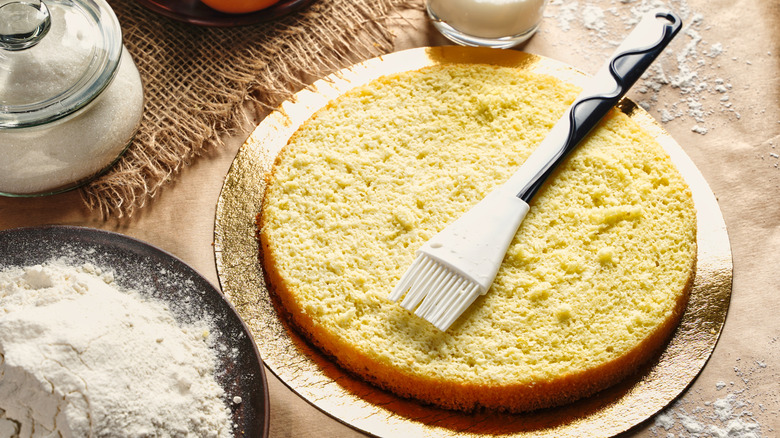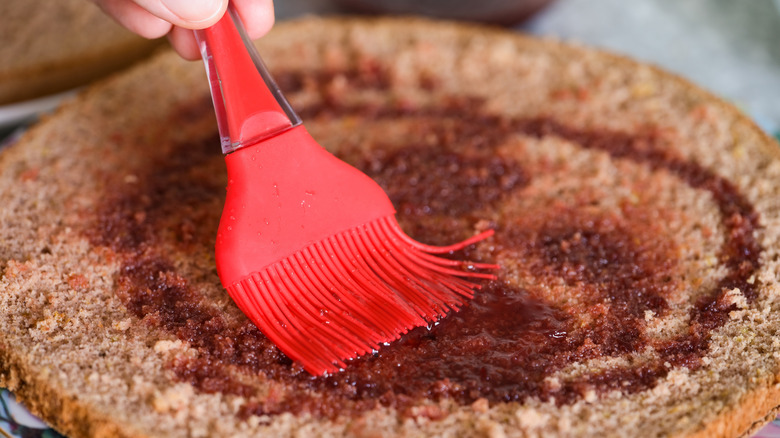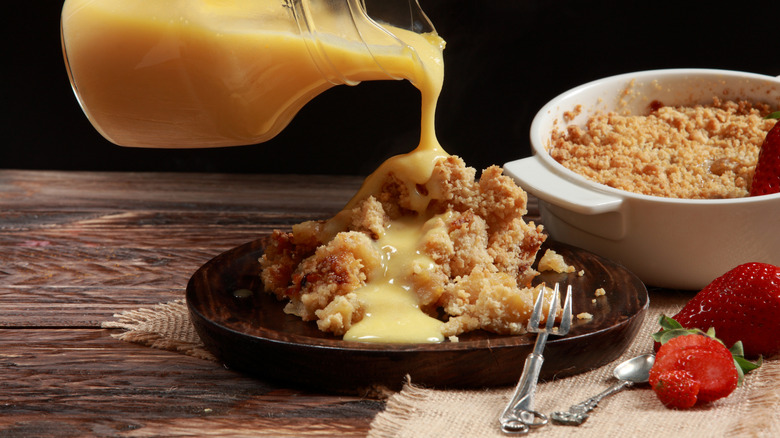The Simple Soaking Technique To Ward Off Dry Cakes
Whether you're celebrating a birthday or just baking for fun, cake is a classic dessert that almost everyone can enjoy ... until you pull it out of the oven and learn that it's dry and crumbly. We already have a couple of pro tips for making sure your cake comes out moist every time, but one simple method is fool-proof: soaking cake sponges with syrup or liquid. To learn more, Food Republic spoke with Dominique Ansel, chef and owner of Dominique Ansel Bakery — home of the famous Cronut. Ansel is joining forces with Talenti Gelato & Sorbetto to debut an exclusive layered dessert that appears to defy gravity as it sits on top of a whisk.
According to Ansel, soaking a cake ensures "you'll get a soft and moist texture, which is especially helpful if the cake base is a drier type of cake ... for example, we'll brush devil's food cake with a bit of coffee or soak almond biscuit with orange blossom water or passionfruit juice, to give it that extra bit of moisture and hint of added flavor."
Some cakes, such as tiramisu, are known for their ultra-moist sponges, but remember that brushing on the liquid (rather than dunking or pouring) is important if you want to keep the cake from getting soggy. "That's why a dessert like tiramisu works and is such a beautiful dessert," Ansel explained, "where the espresso soaks into the ladyfingers, and the moisture from the mascarpone is also drawn in."
How to soak your cake for optimal results
There's more to soaking your cake than just drenching it in liquid and calling it a day. According to chef Dominique Ansel, the liquid you choose "depends on the rest of the flavors in your dessert." Classic options include vanilla bean or simple syrup, but Ansel recommended experimenting: "You can also infuse your soaking with added flavors or ingredients like fresh orange zest, a splash of rum, a tiny bit of rosewater, etc. to give it that little extra touch." You can also use milk or sweetened condensed milk — both of which are found in tres leches cake — to give the texture an extra bit of creaminess.
As with any baking technique, there are always obstacles to get around. When it comes to soaking cakes, Ansel warned against one main mistake: "Make sure not to soak the cake too much. If it starts to fall apart, you've overdone it." For the best results, skip the urge to pour liquid directly over the sponge, which can lead to uneven saturation. Instead, Ansel recommended using "a pastry brush to brush an even layer across the cake."
To soak or not to soak, that is the question
If you're wondering whether or not your dessert would benefit from soaking, it all depends on the cake's base and the texture you're aiming for. The best cakes to soak are those with fluffy sponges, such as a genoise or chiffon, which absorb liquid well — especially if they've dried out too much. And while dry cake typically isn't the goal, some recipes actually call for a drier base. "For example, French toast works best when you use day-old bread, which you can toast up first in order to really get that custard to soak in," Dominique Ansel said. "Serving it with creme anglaise or even a scoop of gelato or vanilla ice cream works beautifully."
In other cases, soaking acts as a rescue mission for an unintentionally dry cake. "[Soaking] can help, but the flavors have to complement the rest of the ingredients in the cake/dessert too," Ansel explained. "Another option is to serve a dryer cake with something creamy or custardy, like pouring warm custard overtop or pairing with a scoop of ice cream or gelato to balance out the textures."
While soaking works wonders for cakes, Ansel advised against using it for dried-out cookies or muffins. Instead, he suggested serving them "with a scoop of ice cream or gelato to make an ice cream sandwich (some of the moisture from the ice cream/gelato will draw into the cookies)."



